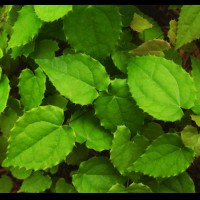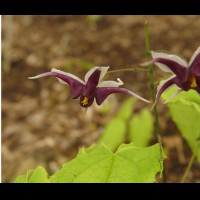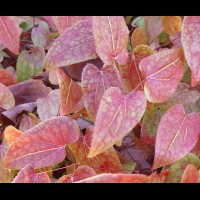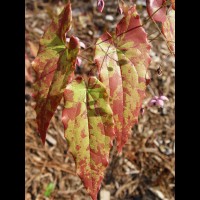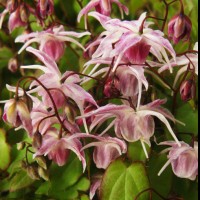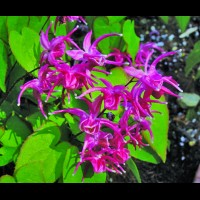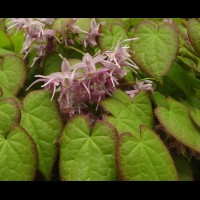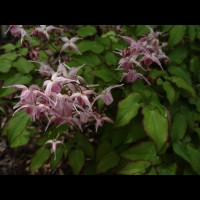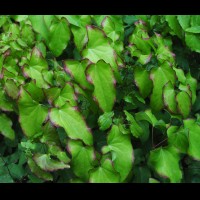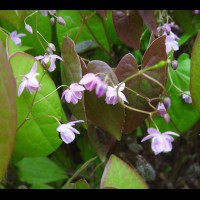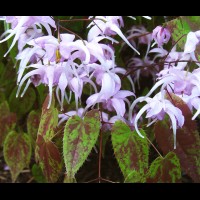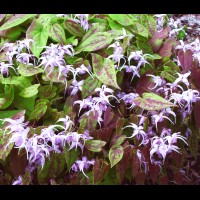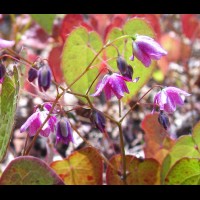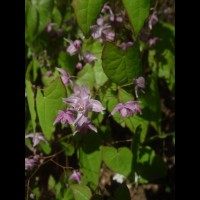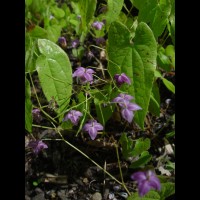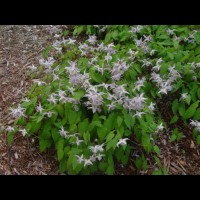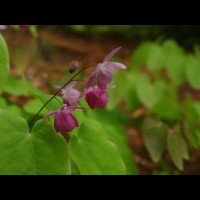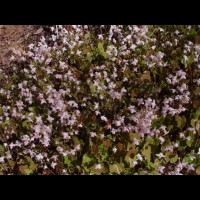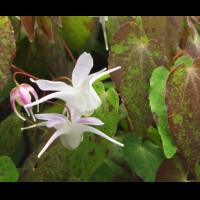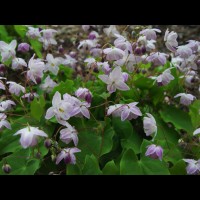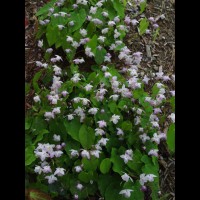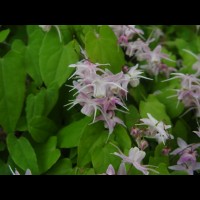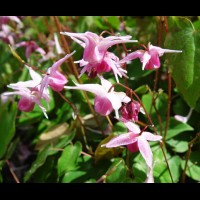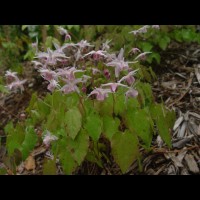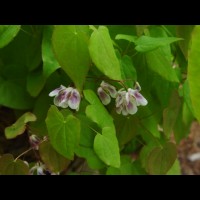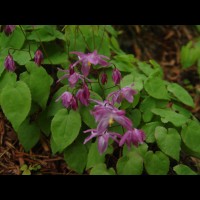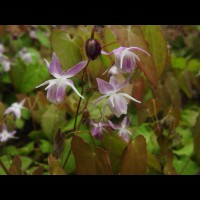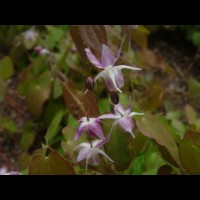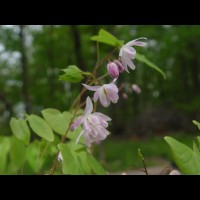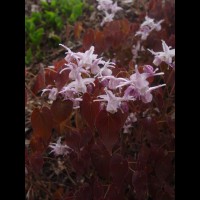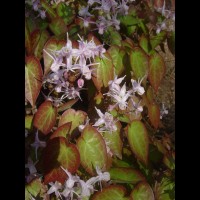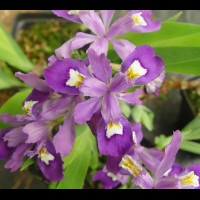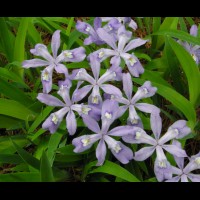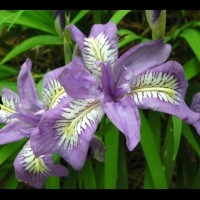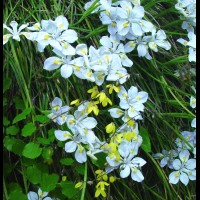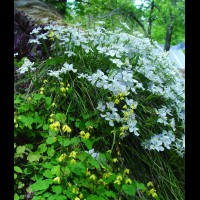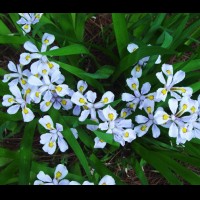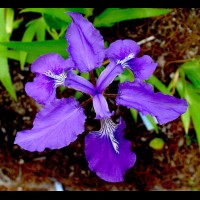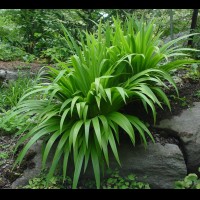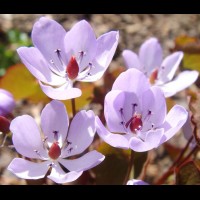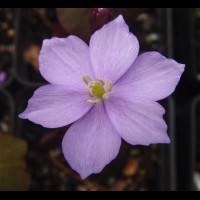Epimedium acuminatum
Epimedium acuminatum (Cc. 930001)
This species was originally collected by Mikinori Ogisu in the late 1970’s, and first introduced into the U.S in 1982. Several new introductions have arrived since, but this clone is the most dwarf at 8-10”. Relatively small evergreen leaflets, bright green in spring with shadows of purple flecks. The large flowers have white inner-sepals and grape-purple petals/spurs. Foliage 8-10" high at maturity.
Epimedium brachyrrhizum
Epimedium brachyrrhizum (Several clones/Cc. numbers)
Discovered in 1994 in Guizhou Province, China, it is one of the shortest species at only 6-8" tall, and among the largest flowered and earliest to bloom, with lavender-pink flowers nearly 2" across! New leaflets may be handsomely mottled with red-maroon in spring. Dark evergreen leaflets have a distinct corrugated surface, and many clones take on maroon overtones in fall. Not available this year.
Epimedium dolichostemon
Epimedium dolichostemon Og. 81010 (Cc. 980078)
Narrow, evergreen, medium-sized arrow-shaped leaflets, heavily mottled with burgundy in the spring. Each small uniquely shaped flower has beautiful, reflexed, white inner-sepals and red petals with short, strongly curved spurs. 18” tall. In 1998, Robin White generously shared a blooming plant.
Darrell was awestruck the first time he saw slides of this clone. Lois Himes, garden assistant to Harold Epstein, took them of a plant exhibited by Robin White when she accompanied Harold to a 1995 Royal Horticultural Society show in London. It is far superior to the Ogisu clone (Og. 81011-- which is unfortunately terribly virused) making the rounds in the U.S.
Epimedium epsteinii
E. epsteinii (Several clones/Cc. numbers)
Discovered in 1994 and named after an outstanding plantsman—the late Harold Epstein. For half a century he grew Epimediums to perfection in his garden “La Rocaille” in Larchmont, NY.
This species has the widest sepals in the genus, nearly 1/2" across and slightly longer, pure white and a striking contrast to the reddish-purple spurs and cup. There are 10 (usually) to 30 of these medium-large flowers per stem. 6-10" tall with medium-sized, dark glossy evergreen leaflets. Spreads 6-8" a year forming a dense low groundcover. Benefits from some winter mulch in Zone 5.
Epimedium fargesii
Epimedium fargesii (Several clones/Cc. numbers)
The typical forms of a very choice species and the main target of Darrell’s November 2000 collecting trip to China. He gathered small divisions from a variety of plants at seven locations. 12-18” tall in bloom, with narrow, medium-sized arrow-shaped, dark evergreen leaflets, that persist in the winter garden.
The medium-sized flowers typically have long, white/pale lavender inner-sepals that wrap around smaller, lavender spurs. Often both reflex backwards. Foliage exhibits dark maroon flecking in spring and sometimes fall. First flush 8-10", second growth flush to 15".
Epimedium grandiflorum
E. grandiflorum (Cc. 920009) (Synonym: E. macranthum)
The typical form of the species in the U.S., with rosy inner-sepals, and creamy-white spurs and cup. The small new spring leaflets have a brown-purple cast to them that nicely complements the flower color. 7" tall in bloom, with a second growth flush to 14".
Epimedium grandiflorum 'Benedict's Violet'
E. grandiflorum ‘Benedict’s Violet’ (Cc. 950130)
This seedling originated in Dr. Herb Benedict’s garden in Hillsdale, MI. Large, reddish-grape flowers hover over young spring green leaflets with a rosy edge. 9” tall with no second growth flush. Very floriferous. A shorter Epimedium that quickly forms a clump.
Epimedium grandiflorum 'Dark Beauty'
E. grandiflorum ‘Dark Beauty’ (Cc. 950132)
Harold Epstein admired this plant for its velvety, deep chocolate-purple new spring foliage. It appeared as a seedling in his garden from an apparent cross between ‘Yubae’ and ‘Silver Queen’. Its large flowers have beautiful dark rose inner-sepals and white petals/spurs flushed with rose. Small leaflets. 8” in bloom with second flush to 12”. A strong grower and one of the first “Eps” to emerge and bloom each year in the nursery.
Epimedium grandiflorum 'First Kiss'
E. grandiflorum ‘First Kiss’ (Cc. 920019)
One of the smallest grandiflorums. Large flowers are produced just above the first set of leaves at only 4” tall. Dark lavender-rose flowers have white accents on the rim of the cup and the spur tips. Small spring leaflets are flushed purple. Second flush to 9”. Its short stature makes it great for troughs or the front of the shade border.
Epimedium grandiflorum 'Lavender Lady'
E. grandiflorum ‘Lavender Lady’ (Cc. 950094)
***2000 Cobblewood Introduction***
This beauty appeared as a seedling in Harold’s garden as a cross between E. sempervirens ‘Violet Queen’ and E. grandiflorum ‘Silver Queen’. Its red leaf color comes from the former and its numerous leaflets from the latter. It forms a mass of wide-spreading, low-growing leaves composed of medium-sized leaflets, their edges suffused with a deep red that fades into a soft green, netted center. This beautiful mass of foliage is topped by full panicles of large, lavender flowers with white spur tips. 8” tall in bloom. No second growth flush. Striking reddish-orange fall color. Early bloomer with a distinctly horizontal growth habit. Semi-evergreen.
Epimedium grandiflorum 'Lilac Seedling'
E. grandiflorum ‘Lilac Seedling’ (Cc. 960019)
Friend Teyl de Bordes of Scotland selected this outstanding seedling from a batch at Washfield Nursery. Medium-large, arrow-shaped leaflets emerge a spectacular deep reddish-purple in spring etched in bright green along the main veins. The color remains for about a month before turning green. 12-18” tall. Dense heads of large light lavender and white flowers are produced below the new leaves. Very showy.
E. grandiflorum 'Lilafee'
Epimedium grandiflorum 'Lilafee' (Cc. 910001)
A popular favorite for its large, delicate, violet-purple flowers with white spur tips held above small, purple-tinted spring leaflets. Reaches 8” tall in bloom with a second flush to 14” tall.
Epimedium grandiflorum 'Mizuhomaru'
E. grandiflorum ‘Mizuhomaru’ (Cc. 970236)
(Synonym: ‘Sakaru Moru’)
A curious Japanese cultivar with spurs that curve sharply inward towards the cup in cold temperatures. This unique flower form makes it a popular choice when seen in bloom at our on-site nursery sales. Medium-sized, pale lavender-purple flowers. Small leaflets. 8” tall in bloom; second growth flush to 12”. Leaves sometimes turn shrimp pink in the fall.
Epimedium grandiflorum 'Mt. Kitadake Purple'
E. grandiflorum ‘Mt. Kitadake Purple’ (Cc. 950031)
Large, intensely rose-violet flowers are held above richly colored foliage. White highlights along the outer edges of the flower resemble crisp white piping. The muted red tones of the early spring foliage later fade to a rosy band at each leaf edge, encircling a light green center with a slight rose blush. The small leaflets are fringed with long white spines, likened to white eyelashes by one of my more enthusiastic customers! 6-7” in bloom, second flush to 10”.
Epimedium grandiflorum 'Pierre's Purple'
E. grandiflorum ‘Pierre’s Purple’ (Cc. 950124)
***1999 Cobblewood Introduction***
Named for Pierre Bennerup of Sunny Border Nurseries who originally shared it with Darrell. 7” tall in bloom, with a second growth flush to 15”. Beautiful, large, rich wine-purple flowers with white spur tips are borne against small leaflets flushed bronze in early spring. The intense spring color of the leaflets elicits many comments during our bloom season, but gradually fades as the flowers age. Leaflets turn a limey green in mid-autumn.
Epimedium grandiflorum 'Pseudo Larchmont'
E. grandiflorum ‘Pseudo-Larchmont’ (Cc. 950115)
***1998 Cobblewood Introduction***
This unusually large, floriferous clone bears masses of creamy-lavender and purple blossoms with arching spurs that billow out from under the edges of the foliage. As a rule, it produces only 9 leaflets per leaf, instead of up to 15, giving bolder texture. The leaflets are dark green, narrow, and distinctively angular in shape. A strong grower, ‘Pseudo-Larchmont’ grows to 8” in bloom, with a second growth flush to 20+”.
Epimedium grandiflorum 'Purple Prince'
E. grandiflorum ‘Purple Prince’ (Cc. 950123)
The richest, deepest purple form of E. grandiflorum that we’ve ever seen. Visitors often remark at its exceptional beauty, even in bud. Spring leaves emerge a muted rose. 8” tall in bloom, with a second flush to 18”. Small leaflets, medium-sized flowers. An early bloomer.
Epimedium grandiflorum 'Queen Esta'
E. grandiflorum ‘Queen Esta’ (Cc. 920021)
A beautiful cultivar named by Harold Epstein after his wife, Esta. It was the first named seedling ever introduced from his garden. Notable for its large flowers with dark lavender inner-sepals and pale lavender spurs held against the chocolate-brown new spring foliage. It grows 6-8” tall in bloom, with a second flush of new dark leaves to 12”. Small leaflets. One of the earliest E. grandiflorums to bloom in spring.
Epimedium grandiflorum 'Silver Queen'
E. grandiflorum ‘Silver Queen’ (Cc. 900003)
Very textural with leaves usually divided into 27 small leaflets that are mahogany-flushed in spring. The large white flowers have "silvery-lavender" highlights on the inner-sepals. 7" tall in bloom, second flush to 11". A parent of many cultivars. An early bloomer.
Epimedium grandiflorum 'Spring Wedding'
E. grandiflorum ‘Spring Wedding’ (Cc. 950237)
2003 Cobblewood Introduction
The fresh spring foliage of this selection emerges dark purple, then lightens and expands to display a bold, 1/4” wide, mahogany-red edge. Very floriferous, it produces numerous flower stems held well above the foliage. The medium-sized flowers have soft lavender sepals backing white petals with downward curving spurs. A plant handsome in both flower and foliage. 10” tall in bloom. Semi-evergreen leaflets hold well into autumn when they turn a limey shade of green. It tolerates alkaline soils better than most E. grandiflorums.
Epimedium grandiflorum 'Swallowtail'
E. grandiflorum ‘Swallowtail’ (Cc. 950238)
***2003 Cobblewood™ Introduction***
A flurry of slim, streamlined and graceful, medium-sized flowers are borne both above and among the numerous small leaflets edged with a hint of purple. The second growth flush has even better foliage color for an extended season of beauty. The flowers have sepals that are blue-lavender streaked in rose. Angular white spurs have a lavender streak and a slight downward tilt. 7” in bloom with a very horizontal growth habit. Second growth to 12". Unlike most grandiflorums, it tolerates alkaline soils.
Epimedium grandiflorum 'Tama No Genpei'
E. grandiflorum ‘Tama No Genpei’ (Cc. 950039)
A floriferous, showy Japanese selection with masses of large, crisp, bi-colored lavender/pink and white flowers held above the foliage. The lovely flowers paired with attractive purple-flecked new spring foliage gives the plant a very soft look in bloom. First blooms are held on 8” stems, with stems elongating to 16”. Small leaflets.
Epimedium grandiflorum 'Waterfall'
E. grandiflorum ‘Waterfall’ (Cc. 950113)
***2003 Cobblewood Introduction***
A large, lively, textural garden plant, full of movement. This appeared as a spontaneous seedling in the garden of Harold Epstein between E. grandiflorum f. flavescens ‘La Rocaille’ and E. grandiflorum ‘Yubae’. The medium-large, acutely tapered leaves stack in layers giving the appearance of flowing water. In spring, purple stippling is strongest at leaf edge, with an irregular mosaic of purple/red and green in the center, fading to green at the petiole. Large flowers gush forth on stems angled upward along the fringes of the foliage. Deep rose-purple sepals angle back from white spurs that flush amethyst as they near the narrow cup. 16” in bloom with colorful second growth to 20".
Epimedium grandiflorum 'White Splash'
E. grandiflorum ‘White Splash’ (Cc. 970198)
Early spring leaflets are marked in a bright batik of olive, apple green, soft salmon-pink and white. As the foliage matures, the pink fades, leaving white irregular patches against a patchwork of many shades of green, lasting well into the season.
This plant came from Japan as “E. grandiflorum – Variegated”. We gave it a cultivar name to distinguish it from the others sold as such in Japan. Flowers are similar to those of the species, with medium-lavender inner sepals and white spurs. A smudge of lavender decorates the white cup. To 12” high.
Epimedium grandiflorum var. violaceum
E. grandiflorum var. violaceum (Cc. 890001)
Exquisite deep chocolate, small, spring leaflets form a lovely background for the bright, medium- lavender flowers. One of the very earliest Epimediums to emerge and bloom in the nursery. Makes a clump 8-10” in bloom, with a second growth flush to 12”.
Epimedium grandiflorum var. violaceum 'Bronze Maiden'
E. grandiflorum var. violaceum ‘Bronze Maiden’ (Cc. 920016)
***1999 Cobblewood Introduction***
Spring leaflets emerge a glossy mahogany-red, resembling molten chocolate. This intense color complements the medium-sized lavender flowers. 8” in bloom, with a second growth flush to 12”. One of the earliest epimediums to bloom. Semi-evergreen.
Epimedium leptorrhizum Y44
Epimedium leptorrhizum Y44 (Same clone/Sev. Cc. num.)
From Guizhou Province in China, its large light lavender-pink flowers and medium-sized leaves are similar to those of E. brachyrrhizum-- elongated and arrow-shaped, with a corrugated texture. However, it spreads by thin rhizomes that grow 8”+ a year with foliage 6-8” tall. Forms a thick, low evergreen groundcover. Reddish fall color. Evergreen.
Epimedium leptorrhizum 'Hubei Treasure'
Epimedium leptorrhizum ‘Hubei Treasure’ (Cc. 001259)
***2005 Cobblewood Introduction***
Traveling along the Sichuan/Hubei Province border in China on a transitional day between target locations in November of 2000, Darrell stopped to stretch his legs. There he found an Epimedium in the cracks of a short cliff along a farmer’s field. With long hairs on the leaves and long rhizomes, he identified it as E. leptorrhizum, and collected a few samples. Fortunately this clone has larger flowers with near-white spurs backed by rich pink inner sepals, a striking deviation from the typical pale lavender-pink blooms of this species. The evergreen leaves are larger than those of the species. Spreads by 2-4" rhizomes.
Epimedium macrosepalum
E. macrosepalum (Several clones/Cc. numbers)
An evergreen and drought-tolerant species from the S.E. coastal region of Russia. The flower of this species makes up for its paucity of flowers with their size. The flowers have enormous (for an Epimedium) inner sepals that are a heavenly shade of lavender-pink. Unlike most inner sepals that follow the curve of the spurs, these petaloid structures reflex back like huge rounded wings, arching above the down curving spurs, like an insect taking flight. Both the cup and the tips of the spurs fade to white. Ground hugging foliage 4-8” high is composed of small to medium-sized rounded, heart-shaped leaflets that turn deep maroon over winter. Its low, running habit makes this species a good groundcover. Vigorously spreads by thin 4-12” rhizomes.
Epimedium macrosepalum 'Sweet Rachel'
Epimedium macrosepalum ‘Sweet Rachel’ (Cc. 040102)
***2010 Cobblewood Introduction***
This beautiful, smaller foliaged form has very shiny, bright burgundy leaves in winter if grown in some sun. The ground-hugging, heart-shaped leaves have the texture of the finest leather. Same beautiful, large rose pink flowers as the species and a reliable bloomer, but with very few flowers. Spreads by thin rhizomes which grow from 4-12”a year. From a plant collecting trip Darrell sponsored in cooperation with the U.S. National Arboretum. Drought-tolerant. Evergreen.
Epimedium sempervirens "Variegated #2"
An exceptional variegated form of Epimedium sempervirens. Strong grower despite the generous amount of foliage that is speckled and splotched with white. Medium lavender-rose flowers. Foliage 6 to 8" high at maturity. Keeps its variegation well into late summer. Limited quantity. Darrell obtained this clone from Japan. It will be a special conversation piece in your garden.
Epimedium sempervirens "Violet"
E. sempervirens “Violet” (Cc. 950069)
One of my absolute favorites. Grown for many years by Harold Epstein, Epimedium enthusiast, this may be a named Japanese cultivar. Medium-sized lavender flowers have spurs that curve inward back towards the cup. Flowers are held above medium-sized leaflets on stems to 9” high. Unusually long, narrow leaflets sport irregular dark flecking in the spring. Semi-evergreen.
Epimedium sempervirens 'Aurora'
E. sempervirens ‘Aurora’ (Cc. 920018)
Dwarf form with large, dark silky, silvery lavender blooms with glossy, small/medium-sized leaflets. 6" tall in bloom with a second flush to 9". The new growth displays occasional dark flecking in spring. Second flush may have a pink blush as the photo shows. Often has good orange-red fall color when grown in bright shade or some sun. Named by Dick Weaver and sold by We Du as a cultivar of E. grandiflorum. Semi-evergreen.
Epimedium sempervirens 'Candy Hearts'
Epimedium sempervirens ‘Candy Hearts’ (Cc. 920038)
***2001 Cobblewood Introduction***
Exquisite spring foliage emerges an opalescent rosy-pink tone that slowly recedes over a month’s time to a rose border, before turning solid green. The showy large silvery lavender-pink flowers have wide inner-sepals and look like iridescent pearls against the colorful spring foliage. 9” tall. Semi-evergreen with medium-sized leaflets.
Epimedium sempervirens 'Koji'
E. sempervirens ‘Koji’ (Cc. 930003)
An attractive Japanese cultivar with sprays of large, medium lavender flowers with white highlights that hover above a mass of medium-sized leaflets 10” tall. New spring leaflets flushed with bronze. A very early bloomer.
Epimedium sempervirens 'Mars'
Epimedium sempervirens ‘Mars’ (Cc. 920035)
A rare, rose-red form of this species, named by Dick Weaver from a plant he purchased from Japan. 6” tall in bloom with a second flush to 10” tall. Medium-sized leaflets. When grown well, ‘Mars’ produces up to 30 or more flowers per stem, forming a dense head. Very showy. Medium/large, dark rose-red flowers. Rusty red/salmon fall color.
Epimedium sempervirens 'Passion Hearts'
Epimedium sempervirens ‘Passion Hearts’ (Cc. 180040)
***2019 Cobblewood Introduction***
A great, new introduction from Massachusetts hybridizer Mark McDonough. Spring foliage emerges a deep chocolate brown and warms up as spring progresses, through a kaleidoscope of vibrant red tones. Eventually the color fades to the edges before greening up in a tidy mound of elongated, heart-shaped leaflets. Generous clusters of medium-sized flowers with light lavender sepals and a lighter cup dot the low mound of colorful spring foliage. Semi-evergreen.
Epimedium sempervirens 'Rose Dwarf'
E. sempervirens ‘Rose Dwarf’ (Cc. 950027)
Originally offered by George Schenk in the 1970’s and still quite rare in the trade. We thank Jerry Flintoff for our original stock. Plants 5” tall in bloom with unusually long, narrow, medium-sized leaflets, gradually tapering to a thin point and flecked with bronze in the spring. Flowers similar to those of Violet Queen’, dark violet-lavender with long inner-sepals. An early bloomer. Semi-evergreen.
Epimedium sempervirens 'Secret Arrow'
Epimedium sempervirens ‘Secret Arrow’ (Cc. 950140)
***2000 Cobblewood Introduction***
Unique, arrow-shaped leaflets distinguish this plant. Large lavender flowers face out¬ward with wide inner-sepals. Cool fall temperatures turn the leaves a beautiful salmon-egg red, with limey green streaks along the main veins
Epimedium sempervirens 'Shadow Dancer'
E. sempervirens ‘Shadow Dancer’ (Cc. 000943)
***2010 Cobblewood Introduction***
This Japanese sempervirens selection has strikingly beautiful banded foliage with a royal purple edge in spring, surrounding a interior flushed with purple. The large, violet-lavender blossoms have uniform coloring throughout. Grows to 12” in height. Semi-evergreen.
Epimedium sempervirens 'Violet Queen'
Epimedium sempervirens ‘Violet Queen’ (Cc. 950138)
A spectacular Epimedium. This clone is an exact match for the plant originally named Epimedium violaceum in 1834 which was later changed to a variety of E. grandiflorum... all through the study of dried herbarium specimens. However, this plant is semi-evergreen and nearly identical to other clones Darrell received from west central Honshu including the plant depicted in Don Elick’s book, Japonica Magnifica. Perhaps it is a species of its own. This is the parent that gifted E. x rubrum, E. x versicolor ‘Versicolor’ and ‘Cupreum’ with colorful spring foliage.
Prized for its vibrant, cherry-red new growth and large, rich violet-lavender flowers with very long inner-sepals. Small/medium leaflets have a long, tapered point. Slow to propagate. 12”
Epimedium sutchuenense
Epimedium sutchuenense (Several clones/Cc. Numbers)
This new Chinese species is from the mountains of southern Shaanxi and northwest Hubei Provinces where it blankets the slopes at approximately 6,000’ elevation. Superficially it resembles E. leptorrhizum, with large, lavender-mauve flowers. Spreads by long, thin 8-12" rhizomes. It produces two leaves on every flower stem, each with three medium-sized, smooth-faced leaflets. Uniformly short at less than 4” tall, it makes an excellent, low, evergreen ground cover.
Epimedium zhushanense
E. zhushanense (Several clones/Cc. numbers)
A new Chinese species, very rare in the trade, discovered near Zhushan and described in 1985. It is similar to E. acuminatum in leaf, flower and its clump-forming habit. The flowers have white or light lavender sepals and deep purple spurs and appear in spring on arching stems. A distinguishing characteristic of its large, evergreen, rough-surfaced spiny leaflets is their wooly undersurface. 8” high.
Epimedium 'Beni Goromo'
Epimedium ‘Beni Goromo’ (Cc. 050046)
A colorful, attractive Japanese cultivar with small, medium-lavender flowers held out in clusters against bronze-maroon spring foliage. The rich flower color lightens toward the tips of the curved spurs. Antique red fall foliage color. Reaches 12”-14”.
Epimedium 'Kaguyahime'
Epimedium ‘Kaguyahime’ (Cc. 950225)
From Japan (via Mikinori Ogisu & Robin White) comes this delicately beautiful hybrid of E. acuminatum and E. dolichostemon. 15-18” stems carry sprays of small flowers with dark reddish-purple spurs and light rose-pink inner sepals. Long, slender arrow-shaped, medium-sized leaflets are jagged edged and beautifully mottled with various shades of red in spring. Vigorous for an semi-evergreen Epimedium, it is one of my favorites, and is named after a popular Japanese folk princess.
Epimedium 'Koharu'
Epimedium ‘Koharu’ (Cc. 050031)
Another floriferous Japanese selection. Medium sized flowers cover this plant. Flowers have a lavender pink cup backed by a lighter pink and white sepals with pink edges and spurs that lighten toward the tips. Flowers are held on dark red pedicels. The small spring leaflets edged in a thin red line.
Epimedium 'Kuki'
Epimedium ‘Kuki’ (Cc. 050002)
Heavy clusters of flowers dripping with deeply saturated color distinguish this beautiful Japanese selection. Numerous full clusters of reddish-purple flowers bloom against a background of fresh spring-green foliage. Each curved spur is tipped in white. A thin red line scribes the edge of each medium-sized new spring leaflet.
Epimedium 'Lilac Cascade'
Epimedium ‘Lilac Cascade’ (Cc. 950236)
***2001 Cobblewood Introduction***
In spring the new foliage emerges in beautiful shades of rose and pink. By bloom time, the leaflets turn almost solid green with a purplish-red border, forming a perfect mound of cascading foliage. Just above the leaves are clusters of rich violet-lavender flowers. Later, a second flush of vibrant hot raspberry-pink foliage emerges and remains colorful for several weeks. 6 to 8” tall in bloom with the second flush to 12-14”. From Darrell Probst's cross between E. sempervirens ‘Candy Hearts’ and E. grandiflorum ‘Yubae’. The foliage is like the former— semi-evergreen, medium-sized round hearts. Drought-tolerant.
Epimedium 'Making Waves'
Epimedium ‘Making Waves’ (Cc. 031433)
A 2003 Collector’s Nursery introduction, named for its exceptional wavy-edged leaflets with a soft, irregular maroon band in spring. Out-facing, long spurred mauve-pink flowers are accented with soft pink and held well above the foliage, on dark, nodding stems. Late blooming.
E. 'Mine No Fubuki'
E. ‘Mine-no-fubuki’ (Cc. 050035)
A delicate Japanese cultivar with chocolate-tinted new foliage, which balloons up to convex, light-green leaflets edged in bronze. Dainty, bell-shaped, spur-less flowers hang from drooping pedicels. They emerge a deep mauve and fade to a light lavender-pink. Delicate in flower with handsome, bold, semi-evergreen foliage to 14”.
Epimedium 'Short Story'
Epimedium ‘Short Story’ (Cc. 170040)
***2019 Cobblewood Introduction***
A showy, robust, new hybrid from Massachusetts breeder Mark McDonough. This unique selection combines the best of evergreen E. brachyrrhizum and deciduous E. grandiflorum. Spring emergence starts with an upright filigree of bronze stems and small leaflets, giving high visibility to luscious clusters of large silvery pink flowers with conspicuously down-turned spurs. As the leaves expand they are mottled in soft red. The flowers are held high and more prominently than in brachyrrhizum, for a fine display. The second flush of semi-evergreen foliage is just as dramatic as the plant is in bloom, boldly marked with bright red over chartreuse green.
Epimedium 'Tanima No Yuki'
Epimedium ‘Tanima No Yuki’ (Cc. 050040)
A charming Japanese cultivar with deep rosy-mauve, bell-shaped hanging flowers held above red stained and speckled medium-sized green leaves to 10”. Provides a riot of color in spring.
Epimedium x sasakii Cc 950137
Epimedium x sasakii (Cc. 950137)
In Japan, wherever the habitats of E. sempervirens and E. x setosum overlap, hybrids occur. These highly variable hybrids were given the name E. x sasakii by Japanese botanists. However, the name is still little recognized by western botanists. All of the clones we've grown so far are semi-evergreen. 6” tall in bloom, second flush to 16”. Small, charming dark grayish-lavender flowers. In spring the leaflets are defined by a dark, thin, mascara-like maroon line at the edge of the leaf. Fall color changes to a taupe or sometimes scarlet with green veining.
Epimedium x sasakii 'Melody'
Epimedium x sasakii ‘Melody’ (Cc. 950230)
***2001 Cobblewood Introduction***
A hybrid between E. x setosum and E. sempervirens—violet, from Harold Epstein’s garden. Medium-sized, spiny, semi-evergreen leaves form a dense clump 7” tall. Lime-green new leaflets are attractively flecked with dark purple in spring. Numerous sprays of small light lavender flowers with tiny, sharply down-curving spurs appear above the foliage to 12”. The foliage often turns red with green veins in autumn. Offers a beautiful flower/foliage combination and is a distinctive addition to the garden.
Epimedium x youngianum 'Akebono'
E. x youngianum ‘Akebono’ (Cc. 980004)
A charming small Japanese cultivar, with ¾” delicate, but full, light rose pink/lavender flowers. Small cup is backed by long, slender, pointed sepals with a white mid-rib. New growth has a reddish-cast at leaf edge. Foliage matures to small, milky-green leaves. 5” in bloom, second flush to 8”. Very floriferous.
Epimedium x youngianum 'Capella'
E. x youngianum ‘Capella’ (Cc. 920045)
Introduced by Dick Weaver and one of Darrell's personal favorites. This clone has charming dark lavender-rose flowers that are small, simple and produced in profusion above small leaflets for a long period in spring. 8" in bloom with second flush to 10" with some re-bloom.
E x youngianum 'Fairy Dust'
E. x youngianum ‘Fairy Dust’ (Cc. 950241)
***2004 Cobblewood Introduction***
Small, simple, lavender-pink flowers with small white spurs lift their faces above the foliage in spring. The color deepens toward the edge of each flower part. Fresh spring leaves have the texture of silk and are tinted in a delicate shade of mocha. Compact growth at 7” in bloom, and flowers to 10”, creating a neat and tidy effect. Early bloomer. Semi-evergreen.
Epimedium x youngianum 'Freckles'
Epimedium x youngianum ‘Freckles’ (Cc. 950080)
***2000 Cobblewood Introduction***
'Freckles' is a seedling that appeared in Harold Epstein’s garden among a mass of ‘Milky Way’, an obvious parent. Large grandiflorum –like flowers with white inner-sepals are flushed and veined lavender with white spurs. Introduced for its pure flower colors, but named for its lively, small spring leaflets, generously speckled in purple. 7” in bloom to 18”.
Epimedium x youngianum 'Fukurasuzume'
E. x youngianum ‘Fukurasuzume’ (Cc. 950064)
A giant among the cultivars of E. x youngianum we've grown. The unique flowers are mostly made up of a “cup”. They have magenta-streaked, white inner-sepals horizontally perched above the nearly spur-less, pendent, white petals. Flowers hang in clusters below the small leaflets, slightly edged in red. 10” in bloom, reaching 15” at maturity.
Epimedium x youngianum ‘Grape Fizz’
E. x youngianum ‘Grape Fizz’ (Cc. 950242)
***2004 Cobblewood Introduction***
Small, rich, grape-purple buds open to release full, blue-lavender blossoms with irregular white highlights at the base of each part. Each flower has four vestigial white spurs. Flowers form a loose tumble above a low 5” mound of lime-green foliage. 7” in bloom. Long lasting bloom. New foliage has a brownish tint. The medium-sized leaves have acute basal lobes and deeply indented veins, producing a seer
Epimedium x youngianum 'Hanagaruma'
E. x youngianum ‘Hanagaruma’ (Cc. 970065)
Ozzie Johnson of Marietta, GA bought this tiny floriferous selection for Darrell in a Japanese nursery. From a low mass of small leaflets only 6” tall, sprout 9” stems carrying many medium-sized flowers. Its grandiflorum-like flowers cluster thickly together just above the foliage, making quite a show. A pale lavender-pink cup and slender spurs are backed by lavender-pink sepals. Second flush to 10”.
Epimedium x youngianum "Japanese Cultivar"
E. ×youngianum “Japanese Cultivar” (Cc. 960051)
A charming Japanese cultivar that Epimedium connoisseur Harold Epstein purchased during his last trip to Japan, but lost the label. Sprightly, medium-sized, rose pink flowers appear above small leaflets flushed purple. White overlays the main veins of each small leaflet all season long. 6” tall in bloom, eventually growing to 9”.
Epimedium x youngianum 'Jenny Wren'
Epimedium x youngianum ‘Jenny Wren’ (Cc. 990568)
***2003 Cobblewood Introduction***
A dainty cultivar from the garden of John Marchacos, Berlin, CT. The small, dark green spring leaflets are speckled and splotched with burgundy against a softer purple wash like the markings of a tiny wren’s egg. Light, lavender-pink, medium-sized flowers stand perky and bright against the mottled foliage. 5” in bloom, to 12”. An early bloomer.
Epimedium x youngianum 'Kozakura'
E. x youngianum ‘Kozakura’ (Cc. 950194)
Siskiyou Rare Plant Nursery bought this unusual clone in Japan as E. x sasakii and offered it in 1995. Unusual in that the inner-sepals drop as the flowers open, leaving only pendulous white petals each with a deep lavender center spot. Small, bell-shaped flowers are borne above small leaflets. 9” tall in bloom. Second flush to 14-16"
Epimedium x youngianum 'Murasaki Juji'
E. x youngianum ‘Murasaki Juji’ (Cc. 970233)
An unusual flower form giving it a "double-flowered" appearance. The petals mimic the inner-sepals in size and shape with short, white-tipped protruding spurs. Full, deep rose-lavender flowers lighten slightly at the center and edges. 7” in bloom. Forms a low, compact mound of dense medium-green foliage.
Epimedium x youngianum 'Murasaki Shikibu'
Epimedium x youngianum ‘Murasaki Shikibu’ (Cc. 970202)
Purchased in Japan in 1997 at Gotemba Nursery, located in the shadow of Mt. Fuji. An adorable plant with a first flush of flowers on short 5” stems. The second flush of leaves/flowers to 9”. Very small new leaflets tinged with purple/brown. Medium-sized flowers have dark rose-purple inner-sepals, paler petals with nearly white, short spurs.
Epimedium x youngianum 'Roseum'
Epimedium x youngianum ‘Roseum’ (Cc. 840003)
The very first Epimedium that Darrell grew as a teenager in Pennsylvania. Produces dainty pale lavender-pink bell-shaped flowers over a long period. 9" tall in bloom with a second flush of small leaflets to 12”. One of the more commonly found varieties in the American market.
Epimedium x youngianum 'Royal Flush'
E. x youngianum ‘Royal Flush’ (Cc. 950239)
***2004 Cobblewood Introduction***
New leaflets emerge a rich chestnut, changing to a bright bur
Epimedium x youngianum 'Starlet'
E. x youngianum 'Starlet' (Cc. 031431)
Introduced by Diana Reeck of Collector's Nursery. Charming medium pink/lavender blooms float over a base of medium-sized elongated leaflets, each edge sponged with deep red in spring. Lighter pink to white highlights the backs of the sepals, the edges of the petals, and the tips of the spurs. Wiry red flower stems complement the spring color of the leaflets. A long-blooming, light and airy and very floriferous selection. 6" in bloom, with a second growth flush of colorful foliage to 11". An early bloomer.
Epimedium x youngianum 'Tamabotan'
Epimedium x youngianum ‘Tamabotan’ (Cc. 930011)
(Synonyms: We Du Special, Special Pink and ‘Pink Ruffles’)
Medium-sized silvery lavender flowers flushed with light lavender hover above new foliage tinted purple with a unique turquoise cast. Petals/inner-sepals similar in size and shape, give the flower a “double” appearance. Small leaflets. 8” in bloom, to 18-20”.
Iris cristata 'Merle's Ruby'
Exceptional for its red-violet rather than the typical blue-violet flower color, very rare in crested iris. This clone was discovered in the wild in North Carolina by a woman named Merle. It was sold for several years by Rice Creek Nurseries, but is not common in the trade. A vigorous grower and a heavy-bloomer. Recently registered with the AIS by Joe Pye Weed’s Garden in Carlisle, MA.
Iris cristata 'Sam's Mini'
Iris cristata ‘Sam’s Mini’
***2006 Joe Pye Weed's Garden Introduction***
Another treasure from Sam Norris, collected by Sam in Olive Hill, Kentucky. A “mini” at only 3-1/2” in height, it has similarly small flowers and compact foliage. Over several years, it forms large dense mats with many bloom stalks. The flowers have a soft appearance and are medium blue-violet with white signals, yellow and white crests with a slightly darker blue-violet halo (Photo courtesy of Jan Sacks)
Iris gracilipes
Requiring similar woodland conditions as Iris cristata, this enchanting Japanese native forms small clumps of arching grassy leaves 6-8” tall. In late May/early June numerous small, 1-1/2” wide violet-lavender flowers terminate thin, wiry stems just above the leaves. Large white signal trans-versed with violet-lavender veins. Small orange crest. Leaves eventually grow to 8” long.
Iris dabashanensis
Iris dabashanensis (Several clones)
(formerly sold under the name Iris henryi)
A newly named Iris species collected by Darrell Probst in N.E. Sichuan Province. Belongs to the same Chinensis section of the genus Iris as I. koreana and odaesanensis, but is very different. Best in bright shade/half-sun and in rock gardens. Forms a 12” by 2’ clump of evergreen, grassy foliage 1/8” wide. In mid-spring, numerous 6” stems emerge, each bearing two 1”+ palest lavender Iris flowers with a small, yellow signal. Pictured here in combination with Epimedium platypetalum.
Iris odaesanensis 'Ice Whisper'
An icy-blue lavender-flowered variant of this normally white-flowered species. Darrell collected a pale lavender-flowered clone in Korea, and grew seed from that plant. This is his deepest lavender-flowered selection.
Semi-evergreen leaves grow to 12" after bloom, forming dense clumps of arching foliage. Half to full sun exposure.
Iris tectorum 'Slippery Slope'
Iris tectorum ‘Slippery Slope’
***2010 Cobblewood Introduction***
Darrell has failed endless times growing the Japanese roof iris in our climate. The flower buds die over winter, starting a rot that eventually kills the plant. He collected this much hardier clone at a high elevation in the Dabashan region of southern Shaanxi Province, China. Here they were pulled up and over the icy mountain by a coal truck in Nov. 2000, hence the cultivar name.
This clone thrives in half sun on an exposed stony ridge in my garden. Best with sharp drainage in light shade/part sun. Large 4” violet blossoms emerge in late spring from 2’ × 2’ bright green foliage fans, giving a tropical appearance to an otherwise New England perennial garden. Spreads slowly, 2-5". per year, by fleshy rhizomes to form a massive clump over time, so give it some elbow room! Needs division every 3-4 years for maximum vigor.
Jeffersonia dubia "Dark Centers"
Jeffersonia dubia “Dark Centers”
Name change to: Plagiorhegma dubia "Dark Centers", but I can't bring myself to call it that.
This plant provides a pop of welcome early spring color as soon as the ground thaws. New leaflets emerge a rusty brown color to contrast with the periwinkle blue/lavender petals. A cranberry colored ovary and dark purple/black anthers add to its charm. These plants are seedlings from plants Darrell collected in the wild in Korea.
Jeffersonia dubia "Putnam's Blue"
Name change to: Plagiorhegma dubia "Putnam's Blue", but I can't bring myself to call it that.
The Asian Twinleaf is a choice perennial that any “real” garden can’t be without, and the more, the better. It blooms very early in spring, usually starting a couple of weeks before the epimediums. Its flowers fade quickly if the suddenly weather heats up. Flowers of "Putnam's Blue" open a deep blue-lavender, and fade with age. The blossoms seemingly float above the rounded, wavy-edged, almost waterlily-like leaves.
Plants bloom at about 4-6” tall, each leaf expanding to 2-3” or so across eventually forming a dense clump 8-10” tall. This selection has the same rusty-red new growth in spring, but is deeper blue-lavender in bloom than ‘Dark Centers’ with a green ovary and longer, fatter, sculpted petals. These are seed grown as Jeffersonia defies division. It originally came from Bob Putnam’s nursery via Jim Jones.
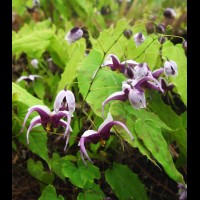
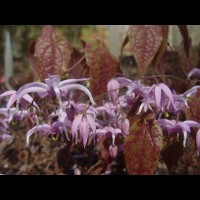
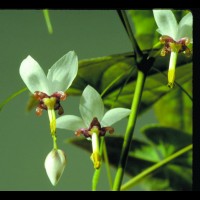
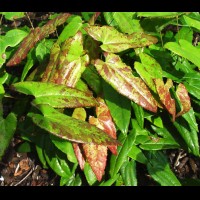
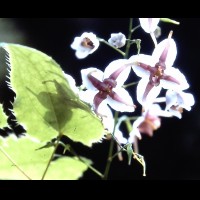
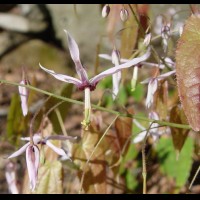
.jpg)
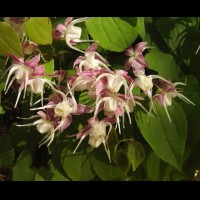
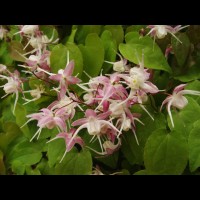
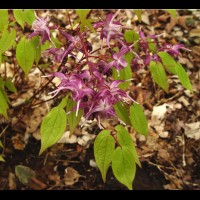
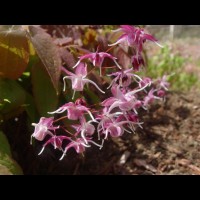
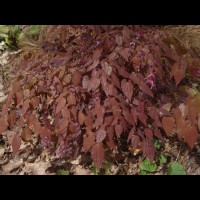
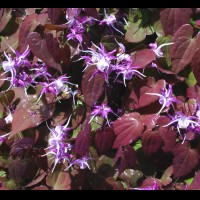
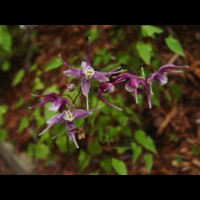
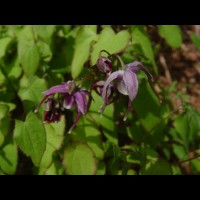
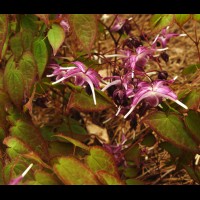
.jpg)

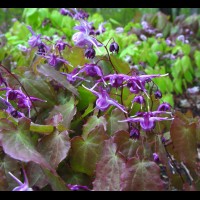
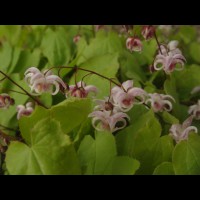
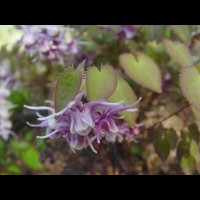
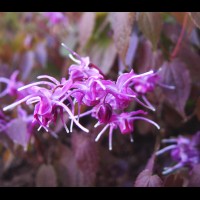
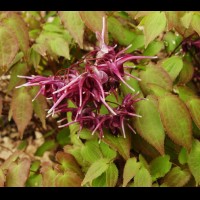
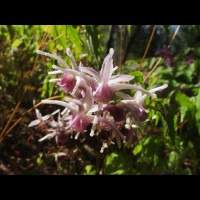

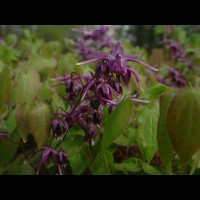
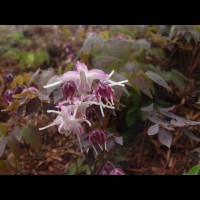
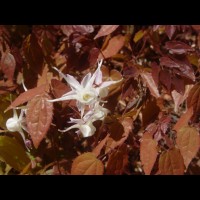


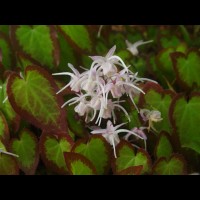

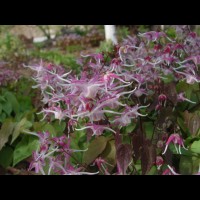
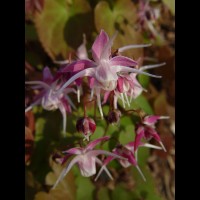
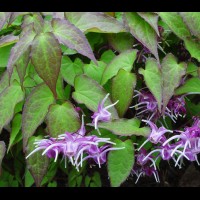
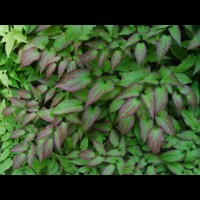
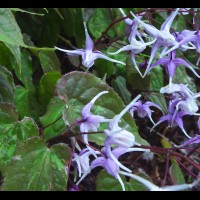
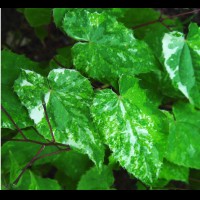
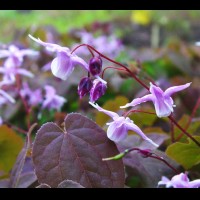
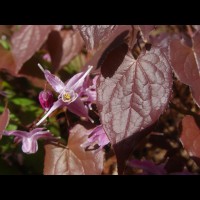
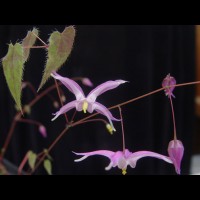
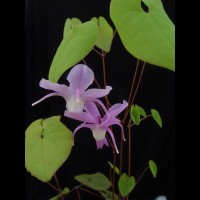
.jpg)

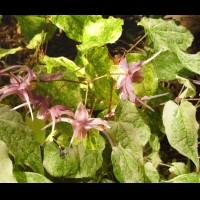
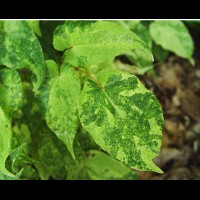
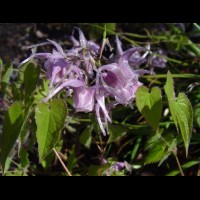
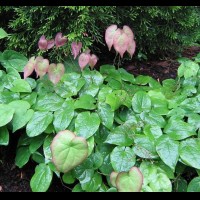
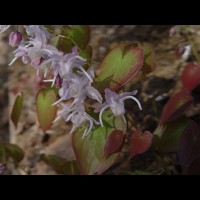
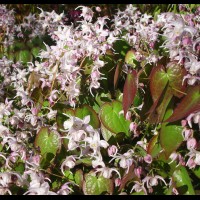

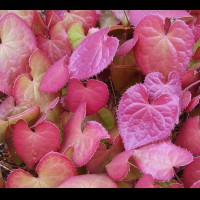
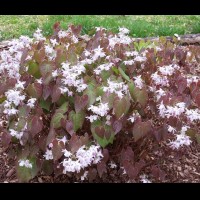
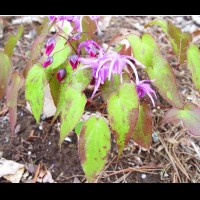
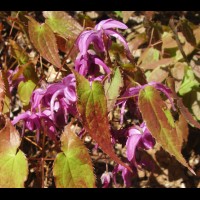
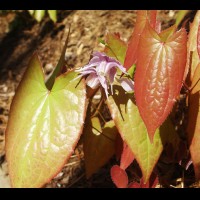
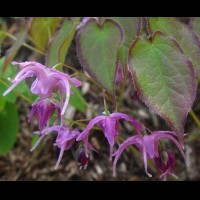
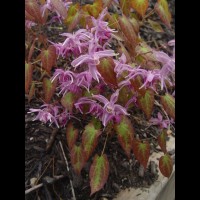
.jpg)
